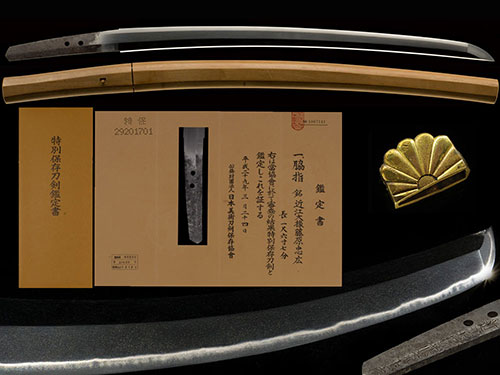
忠広 脇差Tadahiro Wakizashi
No.635429近江大掾藤原忠広 新刀上々作 足葉頻りに入る傑作 一尺六寸七分Oumidaijo Fujiwara Tadahiro Shinto Jojosaku There are many Ashi and You A masterpiece 50.5cm
ご成約Sold
- 銘表Mei-Omote
- 近江大掾藤原忠広近江大掾藤原忠広 Oumidaijo Fujiwara Tadahiro
- 登録証Registration
- 北海道 Hokkaido 昭和40年9月8日 9/8/40(Showa)
- 時代Period
- 江戸時代前期Early Edo period
- 法量Size
-
刃長 50.5cm (一尺六寸七分) 反り 1.3cm
元幅 3.2cm 先幅 2.1cm 元重 0.61cm 鎬厚 0.68cm 先重 0.52cm 鋒長 3.9cm 茎長 15.5cm 重量 575gHachou 50.5cm (一尺六寸七分) Sori 1.3cm
Moto-Haba 3.2cm Saki-Haba 2.1cm Moto-Kasane 0.61cm Shinogi-Thikess 0.68cm Saki-Kasane 0.52cm Kissaki-Chou 3.9cm Nakago-Chou 15.5cm Weight 575g - 国Country
- 肥前Hizen
- 姿Shape
- 鎬造、庵棟、身幅広く、反り尋常、中鋒やや延びる。Shinogidukuri, Iorimune, Wide Mihaba, Standard Sori, Chu-Kissaki slightly extended.
- 鍛Kitae
- 小板目肌つみ、杢目交じり、地沸微塵につき、地景細かく入り、鉄冴える。Small-Itamehada-tsumi, Mixed Mokume, Jinie entered finely, Chikei entered finely, Iron is clear.
- 刃文Hamon
- 中直刃調に、浅くのたれて、小互の目交じり、足・葉頻りに入り、小沸よくつき、匂深く、匂口明るく冴える。Chu-Suguha-style, Shallow Notare, Mixed Small-Gunome, There are many Ashi and You, Small-Nie entered well, Deep Nioi, Nioikuchi is bright and clear.
- 帽子Boushi
- 直に小丸、先掃きかける。Suguni-Komaru, Sakihakikakeru
- 茎Nakago
- 生ぶ、先入山形、鑢目勝手上、目釘孔一。Ubu, Sakiiriyamagata, Yasurime-katteagari, Mekugiana is one(1)
- ハバキHabaki
- 金着一重。A single layer of gold.
- 説明Drscription
- 近江大掾忠廣は、橋本平作郎といい、初代忠吉の子として慶長十九年に生まれ、寛永九年(1632年)父没後に十九歳にして忠廣を襲名している。寛永十八年(1641年)に近江大掾を受領、元禄六年(1693年)に八十歳で没するまでの六十有余年の長きに渡って作刀を続けている。その為、寛永、寛文、元禄期とそれぞれの時代に応じた体配をした数多くの作品を残しているが、新刀の刀工中、初代忠吉に次ぎ、2番目に多く重要刀剣に指定されており、如何に名刀が多いかが伺える。
この刀は、反り尋常、身幅広く、元先の幅差つく慶安頃の作と思われ、小板目肌つみ、地沸微塵につき、地景細かく入る、所謂小糠肌が肌立ち冴えた地鉄に、直刃調に小互の目交じり、足・葉頻りに入り、匂口もふくよかで潤いがあり、地刃が明るく冴え渡っている。Tadahiro Oumino, called Heisakuro Hashimoto, was born in the 19th year of Keicho as a child of the first Tadayoshi, and was named Tadahiro at the age of 19 after his father died in 1632. He received Oumino Tadahiro in the 18th year of Kanei (1641), and has continued to make swords for more than 60 years until he died at the age of 80 in the 6th year of Genroku (1693).
For that reason, he has left many works with body arrangements according to each era, such as Kanei, Kanbun, and Genroku, but he is the second most designated Juyo Token after Shinto's swordsmith, Tadayoshi Ichidai. You can see how many famous swords there are.
This sword is taught to have been made around the Keian period, with standard Sori, Wide Mihaba, Motosaki-habasatsuku. Small-Itamehada-tsumi, Jinie entered finely, Chikei entered finely, The so-called Konuka-hada is on the Hadatachi in clear Jitetsu, Suguha-style, Mixed small-genome, There are many Ashi and You, Nioikuchi is also plump and Uruou, Jiba is bright and clear.


